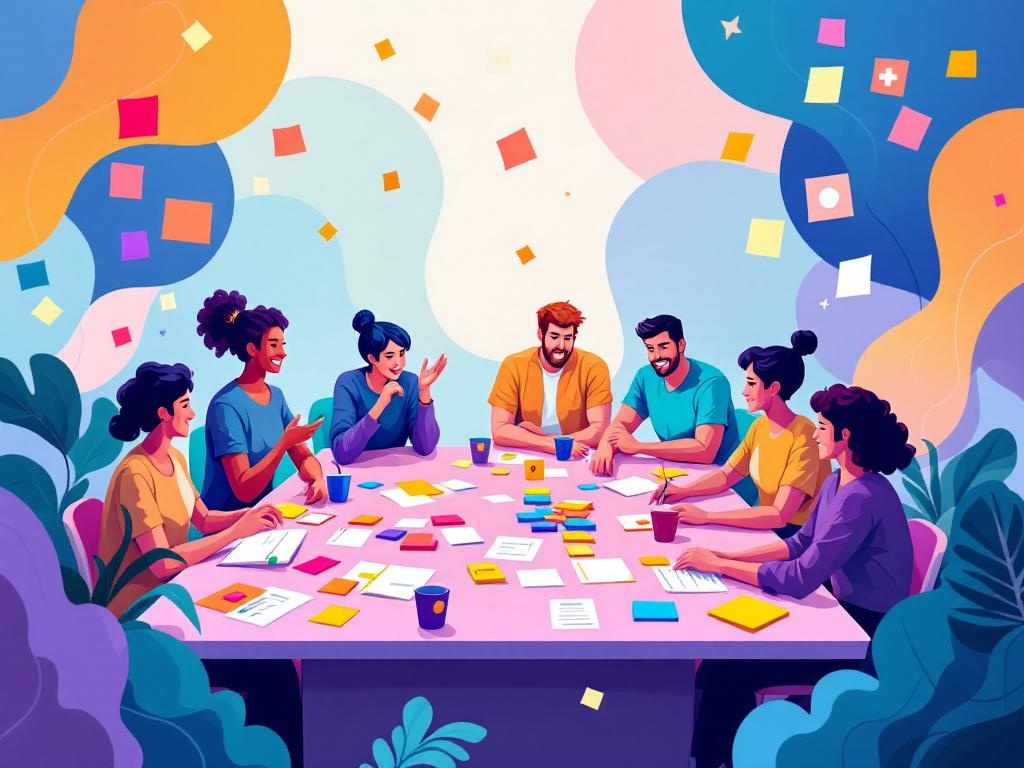
Agile Games for Team Building
Agile games for team building function as interactive tools that transform project management concepts into tangible experiences. These activities enhance collaboration and innovation through structured play. Team building games reinforce core Agile principles while creating an environment of psychological safety where team members can experiment, learn, and grow together without fear of judgment.
Key Takeaways:
- Agile games provide experiential learning that significantly improves team communication and understanding of Agile methodologies.
- Interactive team-building activities help develop trust, creativity, and problem-solving skills across functional boundaries.
- Structured games create a safe space for teams to practice Agile principles through hands-on experiences.
- Experiential learning approaches can improve knowledge retention rates up to 75% compared to traditional training methods.
- Regular team-building games contribute to higher job satisfaction and improved team performance metrics.
The right Agile team building activities offer more than entertainment. They help your team internalize important principles through direct application. Research shows that participants retain information better when they actively engage with concepts rather than passively absorbing them.
Team games break down barriers between departments and create shared experiences. You’ll notice improved collaboration after implementing regular game sessions. These activities encourage participants to step outside comfort zones in a controlled, supportive environment.
Many teams find that problem-solving skills sharpen considerably after participating in collaborative Agile exercises. The games simulate real-world challenges while removing the pressure of production environments. This allows team members to experiment with different approaches without risking project outcomes.
For remote teams, digital adaptations of popular Agile games maintain team cohesion across distances. Virtual whiteboards and collaboration tools make these activities accessible regardless of physical location. The key lies in selecting games that translate effectively to digital formats while preserving their interactive nature.
Companies report significant improvements in sprint velocity and quality metrics after incorporating regular Scrum-based games into their routines. The playful context helps teams identify and address process inefficiencies without defensive reactions that often accompany formal reviews.
“Agile games transform abstract project management concepts into interactive experiences, fostering collaboration and innovation while cultivating a safe space for growth and experimentation. By engaging in structured play, teams not only reinforce core Agile principles but also build trust and creativity, resulting in improved communication and heightened job satisfaction.”
Understanding Agile Methodologies and Their Evolution
Agile methodologies serve as frameworks for iterative and incremental project management, enabling teams to respond to change rather than following rigid plans. The Agile Manifesto, created in 2001, established four core values and twelve principles that revolutionized software development and project management approaches.
Industry adoption has skyrocketed, with 95% of organizations now implementing some form of agile practices according to the Digital.ai 2020 State of Agile Report. The shift from traditional Waterfall approaches to Agile has delivered measurable benefits in delivery speed, flexibility, and customer involvement throughout the development process.
When implementing agile games for team building, you’ll find they reinforce core Agile principles while strengthening team bonds. These activities create an environment where psychological safety flourishes – a key element identified in Google’s Project Aristotle as essential for high-performing teams.
Scrum and Kanban remain the most widely adopted frameworks, each offering structured approaches to implementing Agile values. Organizations report significant ROI from Agile adoption, with 60% experiencing faster time-to-market and increased productivity according to VersionOne’s annual survey.
The Psychology of Effective Team Building
Successful Agile implementation depends heavily on creating cross-functional, self-organizing teams. Research shows that team building through communication exercises significantly improves collaboration and innovation potential.
The most effective agile games for team building focus on:
- Enhancing psychological safety to encourage experimentation
- Building trust through shared problem-solving experiences
- Developing communication skills through structured activities
- Creating shared understanding of Agile principles
- Fostering creative thinking and innovation
- Breaking down silos between team members and departments
These team-building activities serve a dual purpose – they reinforce Agile methodologies while simultaneously strengthening interpersonal connections. Scaled Agile Framework (SAFe) principles recommend regular team-building exercises to maintain alignment in large enterprises.
| Game Type | Core Benefit | Example Activity |
|---|---|---|
| Communication Games | Reduces misinterpretation | Emoji Communication |
| Workflow Games | Optimizes processes | Ball Point Game |
| Retrospective Games | Encourages reflection | Sailboat Retrospective |
| Problem-solving Games | Builds collaboration | Marshmallow Challenge |
| Simulation Games | Teaches Agile principles | Paper Airplane Factory |
By incorporating these agile explained activities into your regular team routines, you’ll create an environment where continuous improvement becomes instinctive. The experiential learning provided through these games produces significantly higher retention rates compared to traditional training methods.

The Science Behind Effective Agile Teams
The success of agile teams depends on specific factors that science has proven create high-performing groups. Google’s Project Aristotle research identified psychological safety as the most crucial element—team members must feel comfortable taking risks without fear of judgment. When you create an environment where people can freely express ideas, your agile games for team building efforts will yield better results.
Cross-functional, self-organizing teams form the backbone of successful agile implementation. These teams bring diverse perspectives together, fostering innovation through collaboration rather than top-down management. The Digital.ai 2020 State of Agile Report shows that 95% of organizations now use agile practices because they recognize these team structures deliver results.
Building Psychological Safety Through Play
Agile games for team building create the perfect conditions for developing psychological safety. These structured activities allow your team to:
- Practice communication in low-risk environments
- Build trust through collaborative problem-solving
- Develop empathy by understanding different work styles
- Experience failure without real-world consequences
- Reinforce agile principles through experiential learning
The correlation between agile team-building activities and higher job satisfaction is significant. When you incorporate regular team games into your workflow, you’ll notice improved employee retention rates. Teams that play together stay together because they’ve developed genuine connections.
You can measure team health using indicators like velocity consistency, retrospective action completion rates, and quality metrics. The team building through communication exercises particularly help establish the foundation for successful agile implementation.
Implementing frameworks like Scaled Agile Framework (SAFe) requires strong team cohesion, especially in large enterprises. Agile games create a common language and shared experience that transcends departmental boundaries. When your teams understand how their work interconnects through practical exercises, you’ll see improved coordination and fewer handoff issues.
The effectiveness of experiential learning surpasses traditional training approaches. According to VersionOne’s annual survey, 60% of organizations report faster time-to-market and increased productivity after implementing proper agile practices, including team-building activities. When you engage your team through fun games to play team building exercises, you’re creating the conditions for sustainable success.
Rather than viewing agile games for team building as optional bonding activities, recognize them as essential tools for establishing the psychological foundations needed for agile success. By understanding the science behind effective teams, you’ll make more informed choices about which games will best address your specific team development needs.
According to a study by Google, teams with high psychological safety are 2.3 times more likely to be high-performing.
hbr.org
Experiential Learning Through Agile Games: Core Concepts
Agile games for team building represent structured activities that teach agile principles through hands-on experience rather than theoretical instruction. These interactive exercises create a safe space where teams can experiment with agile concepts, make mistakes, and learn collectively without real project risks.
Learning by doing produces significantly higher retention rates compared to traditional training methods. Research shows participants retain approximately 75% of knowledge gained through experiential activities versus only 5-10% from lecture-based learning. This makes agile games particularly valuable for teams transitioning to agile methodologies.
The core benefits of integrating agile games into your team development include:
- Enhanced communication across functional boundaries
- Improved collaboration and trust between team members
- Hands-on understanding of abstract agile concepts
- Boosted creativity and problem-solving capabilities
- Increased engagement through fun, competitive elements
- Better application of principles to real-world scenarios
Most effective agile games follow a three-part structure that maximizes their impact on your team:
- Simulation – Teams engage in a time-boxed activity that simulates specific agile challenges
- Reflection – Guided discussion helps participants process what happened and why
- Application – Teams identify how lessons apply to their actual work environment
You can categorize agile games based on their primary learning objectives:
- Communication games – Focus on information sharing and listening skills
- Workflow games – Demonstrate bottlenecks, dependencies, and process optimization
- Estimation games – Improve accuracy in planning and forecasting
- Retrospective games – Encourage honest feedback and continuous improvement
- Problem-solving games – Develop creative approaches to complex challenges
When implementing agile games for team building, consider the team’s current development stage. Newer teams benefit from simpler activities focusing on agile fundamentals, while experienced teams need more complex games addressing specific challenges they face in project collaboration.
Types of Agile Games
Different game formats serve various learning needs:
- Physical games – Activities like the Ball Point Game help teams understand workflow optimization through tangible objects
- Visual games – Exercises using sticky notes or whiteboards visualize work progress and bottlenecks
- Role-playing games – Simulations where participants take on specific roles to understand different perspectives
- Digital games – Online tools that facilitate remote team participation in agile learning experiences
The effectiveness of these activities stems from their ability to create memorable learning moments while building psychological safety – a critical foundation for successful team building through communication. Teams that regularly engage in agile games develop stronger bonds and demonstrate better performance metrics in their actual project work.
Experiential learning can improve retention rates significantly, with estimates suggesting that individuals retain as much as 75% of what they learn through hands-on activities, compared to only 5-10% from traditional lecture methods.
forbes.com
Top Agile Games for Team Development
Agile games transform abstract concepts into tangible experiences, making them powerful tools for enhancing project collaboration and team cohesion. You’ll find these interactive exercises particularly effective for reinforcing agile principles while building stronger teams.
The Paper Airplane Factory game teaches iterative development through rapid prototyping cycles. Your team will design, build, and test paper airplanes across multiple sprints, learning to improve designs based on feedback. This agile game for team building demonstrates how time-boxed iterations lead to better products and highlights the value of customer feedback.
Ball Point Game reveals the power of self-organization and continuous improvement. Teams must pass balls through a defined system, tracking how many they complete in each round. You’ll typically see 30-50% throughput improvements as teams adapt their processes, making this an excellent agile game for team building that showcases workflow optimization principles.
The Marshmallow Challenge develops adaptive thinking and collaboration. Using just spaghetti, tape, string, and a marshmallow, your team must build the tallest free-standing structure. This exercise teaches rapid prototyping and risk response strategies as teams learn that testing assumptions early prevents late-stage failures.
Try these additional agile games for team building to target specific skills:
- LEGO Tower Challenge: Enhances communication between “customer” and “builder” roles
- Emoji Communication Game: Highlights interpretation challenges in distributed teams
- Sailboat Retrospective: Visualizes progress and obstacles through an accessible metaphor
- Coin Flip: Demonstrates the value of small batch sizes in workflow management
- Planning Poker: Builds consensus around effort estimation
The effectiveness of these agile games stems from their experiential nature. According to the Digital.ai 2020 State of Agile Report, organizations implementing such team-building exercises report faster skill adoption and improved team dynamics. You’ll find these activities particularly valuable during team building through communication initiatives and agile transformations.
Implementing Agile Games Effectively
For maximum impact, structure your agile games for team building with clear learning objectives. Always include a facilitated debrief after each activity to connect game experiences with workplace applications. You can rotate facilitation responsibilities to develop leadership skills across your team.
Create a safe environment where participants can experiment without fear of failure. This psychological safety forms the foundation for the continuous improvement mindset essential to agile practices and continuous improvement initiatives.
Organizations that embrace agile methods report a 60% improved team collaboration and a 70% increase in project success rates, thanks to interactive team-building activities that foster communication and trust.
forbes.com






